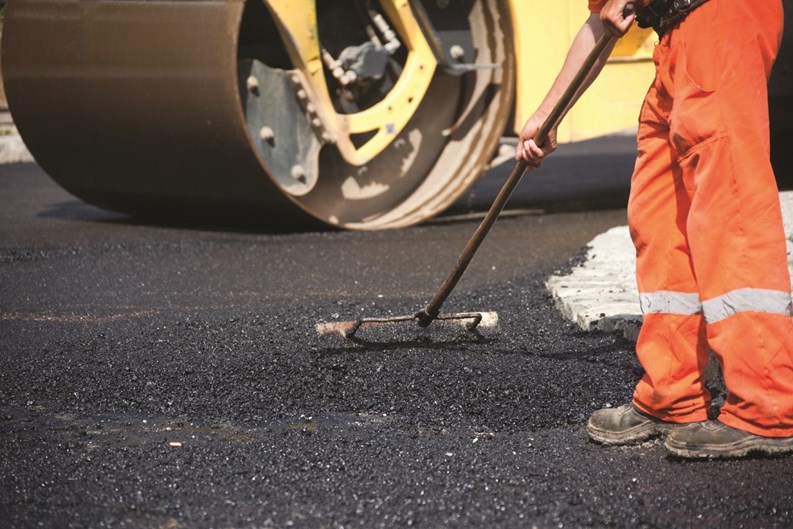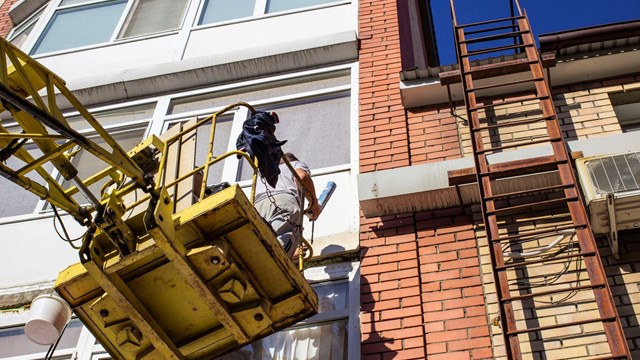How solid is the ground on which you walk and drive upon in your community? The answer might surprise you, as could the amount of money that might be seeping from your community’s bank account from unnecessary repairs to driveways, parking lots, and sidewalks.
Whether taking the form of sidewalks, parking lots and slabs, driveways, pool decks, or outdoor design elements, paved surfaces are everywhere in New England’s condominium communities. Caring for and repairing these acres of asphalt (as well as the community’s concrete, pavers, etc.), is a tedious task. The management has the responsibility of keeping the pavement outside front doors in good shape; but it’s also in the interest of everyone in a community to keep an eye on these parts of the infrastructure.
Understanding the various materials, methods, and technologies involved in paving located in a condominium community might seem purely the bailiwick of property management, and not a concern of the resident or board of trustees member. Still, it makes sense to save dollars. Having a clue on whether the asphalt parking lot just needs a patch or major renovation could save everyone in the association a lot of time and money.
Firm Foundations
Knowing about paving means understanding the materials used for such projects. Just as some contractors are better at doing certain projects and not as great at working on other types of jobs, however, the correct material for the project may not be the one that seems best at the outset. Sometimes, when everyone is clamoring for new asphalt, concrete could be needed, or vice versa.
Generally speaking in New England residential communities, parking lots are asphalt, and sidewalks, patios, and pool pavements are concrete. The differences are distinct: asphalt is made of big and small rocks, sand, and petroleum; it’s flexible, and cures over six to 12 months. But strictly speaking, asphalt never really “sets up”—it stays flexible, unlike typical concrete, which becomes a solid, rigid surface after it cures.
Concrete is made of crushed stone, sand, and cement, and is often used for sidewalks and patios. Also, it can be used for parking lots, although some communities choose to pave these (and driveways) with asphalt, because it costs less than concrete in most cases. And because it is more flexible, it can accommodate the weight of vehicles without cracking.
There are advantages to using each of the materials, including lifespan and maintenance. If installed correctly, concrete has a 20-year life span (or longer); asphalt’s is shorter, depending on environmental conditions. The elements help wear down this material such as cold temperatures, rain, snow, and heat.
In New England’s climate, asphalt can become deformed. Sometimes, the combination of heavy vehicle traffic—like large trucks—can cause ruts in the heat-softened asphalt. Other factors—like oil dripping from the engines of cars—can wear away at an asphalt surface and cause pitting. And then, of course, there’s the “Old Man Winter” factor, with last winter—January and February—as a prime example. A season like that, says Paul Baldasaro, marketing and sales manager at Asphalt Services, Inc. in Woburn, Massachusetts, “will have terrible effects. When you have as much snow and cold as we did, it can cause havoc on your parking lot. Plows damage curbing, fences and the asphalt itself. The piles of snow seep into the asphalt, causing heaving under the asphalt, which leads to bad cracking and potholes. The worse the winter is, the worse off your parking lot will be when it’s over.”
Start at the Beginning
Improper installation can be a fatal flaw in the longevity of an asphalt surface, according to experts. If the asphalt is not installed at the correct temperature, it won’t cure properly.
“If asphalt is not installed properly it will fail much quicker,” warns Nathan Green, an account executive with KCI Paving & Concrete in Smithfield, Rhode Island. “It will not last as long if the sub-base is not compacted.”
Correct installation also includes a sealcoat (applying a sealer to the surface). This treatment should be done yearly, some experts recommend, to get the longest life out of the asphalt pavement, although Baldasaro notes that condominium parking lots are more typically sealed every two to three years. Usually, seal coats are one of two types: coal tar or a petroleum-based product called asphalt emulsion sealer.
But eventually, the wear and tear of vehicles and the effects of New England weather create unsightly (and potentially dangerous) paved areas that crack sealing and seal coating can’t rescue. When a community is on a tight budget and the lot already was paved in asphalt, it makes sense to repair or repave in asphalt. But just because the community has an asphalt parking lot that needs to be replaced, doesn’t mean the best solution is asphalt paving for the new job. Sometimes, experts suggest, an overlay of two inches of concrete atop the existing asphalt pavement can be an effective remedy.
Consequently, an association’s management must count on its professional consultants to help with such decisions. The more specific the questions regarding paving, the more these matters are referred to professionals. When it comes to spending thousands of dollars on a new parking lot (or another paved surface), it can be wise for board members to trust their property manager, and especially count on an engineer, in order to ascertain the right material for the job.
It’s also important to recognize signs that the paved surface is breaking down as soon as possible. If caught early, the problem might be solved by a not-too-costly repair. If caught later, it might mean a total parking lot replacement, or even worse—a drainage system and parking lot replacement.
In fact, Baldasaro says, neglect is one of the biggest mistakes that condo boards and managers make in regard to their parking areas. “The parking lots are usually the last thing on a property manager’s or owner’s mind, but they shouldn’t be,” he says. “The parking lot is a first impression for a visitor to the property. When a parking lot looks really bad, some would assume the same care is given to the building. Also, a parking lot is a big injury concern. Potholes and heaving in concrete or asphalt will create tripping hazards where a person can get seriously injured. Properly maintaining your asphalt will keep your lot looking great and extend the life of the parking lot itself.”
Noticing Cracks
In addition to rutting caused by heavy traffic and pitting caused by fluid leaks, asphalt can crack when breaking down, which could lead to a more pervasive problem. Surface cracks allow water into the underside of the pavement; then, it can collect in the subsurface and start breaking down the pavement.
The subsurface is the foundation of the asphalt; if compromised, the entire paved area may need replacing. Hence, an engineer (or other competent professional) must identify the exact nature of the problem. Occasionally, a community’s management and board simply bandage a problem…one that needs much more attention. Their engineers and other professional consultants need to advise them against this incongruity.
Just as with blacktopped roofs in cities, asphalt paving traps more heat than concrete, creating another potential disadvantage of using asphalt pavement in a residential community; it creates “urban heat islands,” says Bill Davenport, vice president of communications for the American Concrete Pavement Association based in Rosemont, Illinois.
“Urban heat islands can be 10 degrees to 20 degrees hotter than surrounding areas,” Davenport says. “The sun bakes down on those dark areas, which retain the heat, and sometimes never entirely cool off at night.”
Concrete paving—especially the traditional, impermeable kind that’s made of Portland cement—also is susceptible to water infiltration and the damage it causes. That’s why even small cracks, or “spalling” (when the surface of the concrete begins to flake off), must be repaired immediately before a small fix turns into a major replacement.
Problems with concrete paving can begin the day of installation. A concrete mix must have the correct amount of water or the batch can be weakened. On public or government jobs, batches are tested for quality control. But cement testers are pretty much unheard of on residential projects. That’s why it’s important for a board to ensure that the community’s engineering consultant oversees jobs, and make sure that the contractor is reliable and trustworthy.
All paved surfaces must be overseen by the property manager and engineer from installation and throughout their life spans. If the community is professionally managed, the manager or engineer should inspect all of the paving yearly.
Certain seasonal maintenance steps must be taken to keep pavement in good shape, Baldasaro says. As soon as winter ends, inspection time begins. “Property managers and owners should be on the lookout for potholes; that’s Number One. They should also assess all their drains, that they’re working correctly and look to be in good structural shape. Any new cracking and damaged areas in asphalt should be noted along with damaged curbing and signage.” All parking lots should have debris removed and swept clean. Landscaping around paved areas should be trimmed and disposed of, too. That kind of attention should continue throughout the year, as each season imposes its own challenges on those constantly-used surfaces.
In the end, your board and management team don’t have to be experts on paving to keep your community’s surfaces safe, attractive, and functional—they just need to understand the basics, follow seasonal maintenance tips, and know who to call when a problem arises.
Jonathan Barnes is a freelance writer who regularly contributes to New England Condominium. Associate Editor Pat Gale also contributed to this article.







Leave a Comment